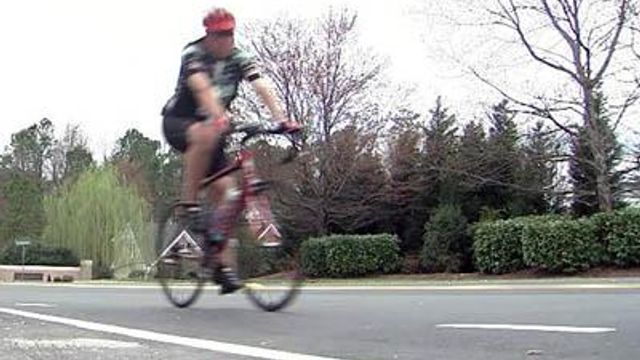Group wants to boost cyclist safety through education
An Orange County group is trying to get area governments to endorse guidelines for bicycling safety that members say will reduce the number of crashes involving cyclists on rural roads.
Posted — UpdatedThe Rural Road Safety Coalition says it isn't trying to change state traffic laws, noting it also hopes that local cycling clubs and other organizations endorse the guidelines.
"The education part is important," said Maria Falbo, a cyclist and manager of The Bicycle Chain shop on Franklin Street in Chapel Hill.
According to figures from the state Division of Motor Vehicles, 92 bicyclists were killed in crashes on North Carolina roads between 2007 and 2011. There were an average of 540 wrecks involving bikes in each of those years.
Orange County had the second-highest fatality rate in the Triangle during that period, with nine cyclists killed. Twenty-six cyclists died on Wake County roads.
Falbo and cyclist Trent Cox said rural roads often pose more danger to cyclists than busy city streets.
"(There are) people throwing things out of cars, just riding too close, and then turning when I'm turning, you know, not realizing that I'm a vehicle and I have the lane," Falbo said. "Those bad experiences kind of stick with you because, you know, it only takes one time to get really hurt."
"I've had people honk at me. I've had people, you know, speed around (me) really fast," Cox said. "You sort of swerve a little bit, so it can be a little scary."
The suggested safety guidelines for drivers include learning cyclists' hand signals for turning or slowing down, passing cyclists only if there is at least 500 feet of clear sight ahead and never on a curve or hill, giving cyclists at least 4 to 6 feet of space while passing and even more near driveways and intersections where gravel and other debris might force them further into the center of the road and avoiding sudden noises or erratic driving that could startle a cyclist.
Yet, veteran cyclists say they know safety goes both ways.
"Sometimes, bikers will kind of breeze through stop lights or stop signs," Cox said.
"I don't like riding in those groups where they are riding four and five abreast and taking up the whole lane and then sometimes crossing the double yellow (line), which is dangerous," Falbo said.
The suggested safety guidelines for cyclists include wearing helmets and reflective clothing and using lights and mirrors for safety, avoiding the use of headphones or cellphones while riding, breaking large cycling groups into groups of fewer than 12 riders in single file and having members of each group act as lookouts for oncoming and following traffic and spreading the message through the group.
"They are all really great ideas, you know, if we can remember that we are all just human beings trying to get some place," Falbo said.
• Credits
Copyright 2024 by Capitol Broadcasting Company. All rights reserved. This material may not be published, broadcast, rewritten or redistributed.





